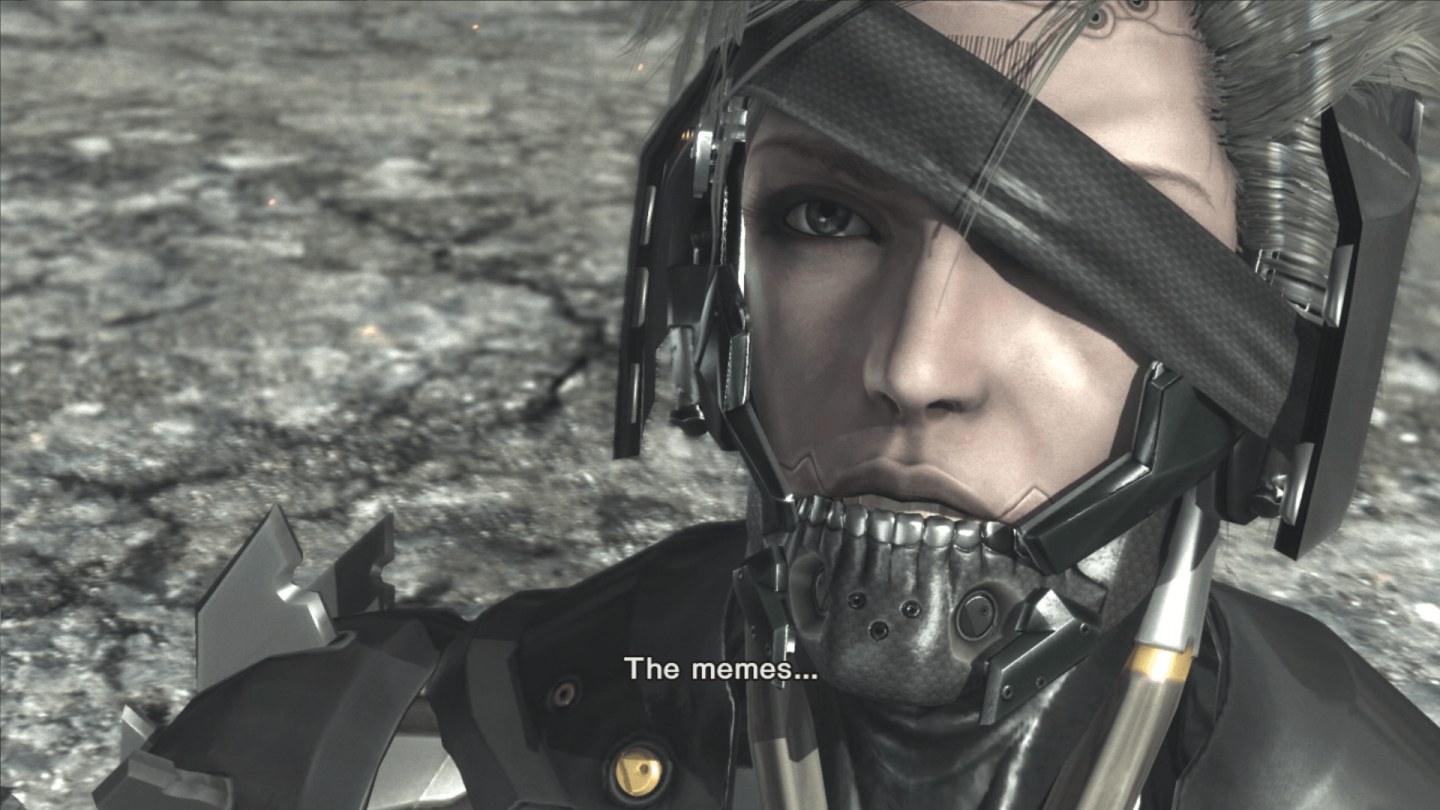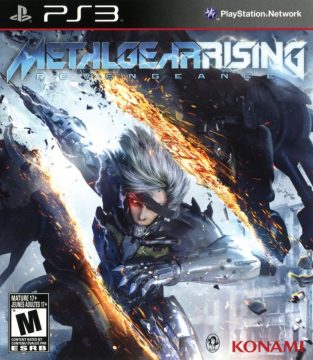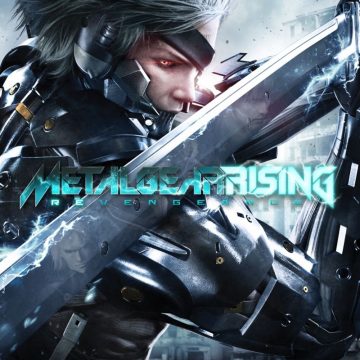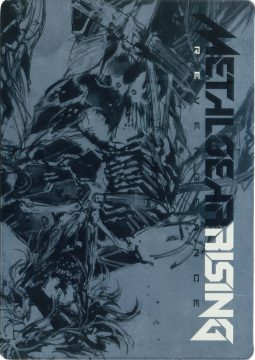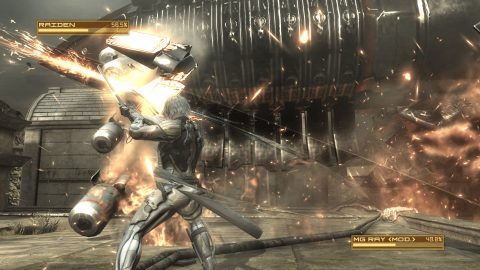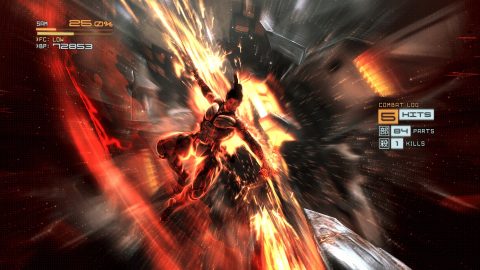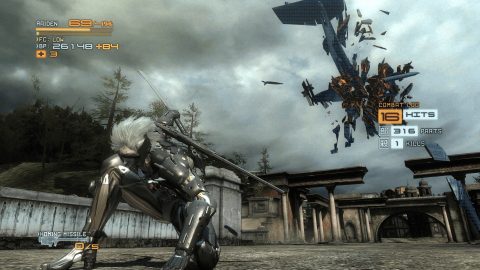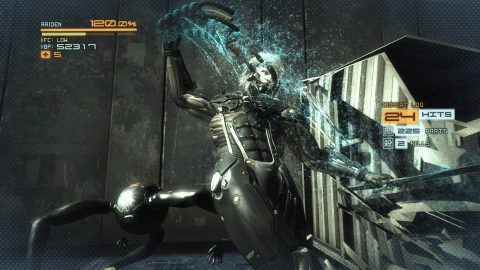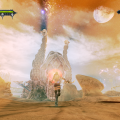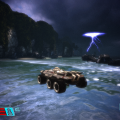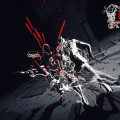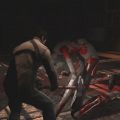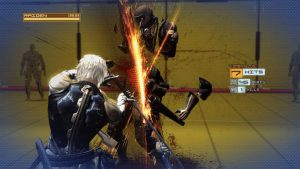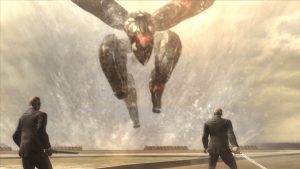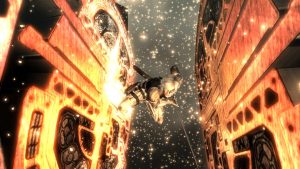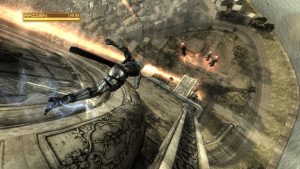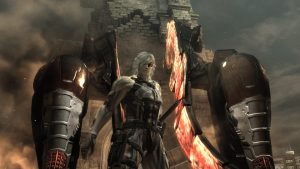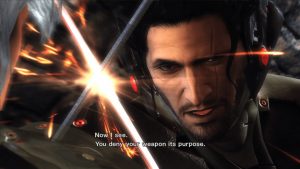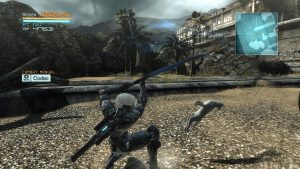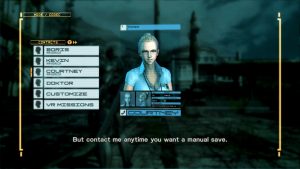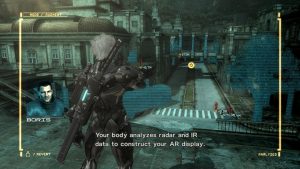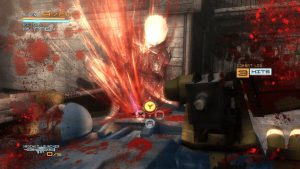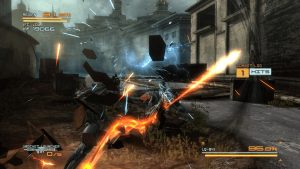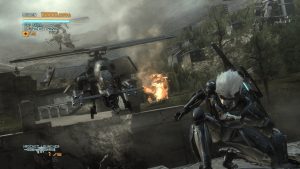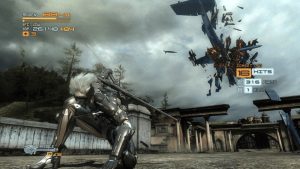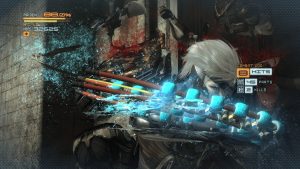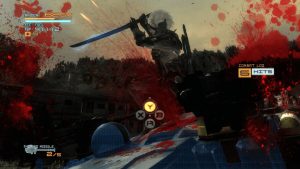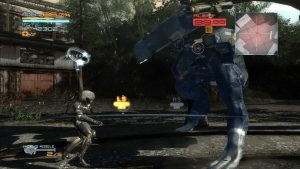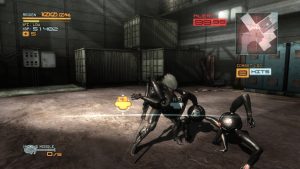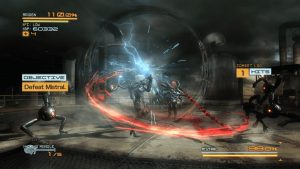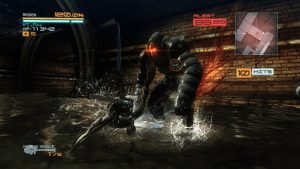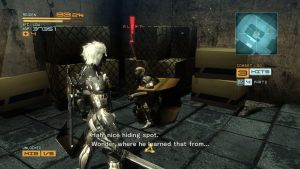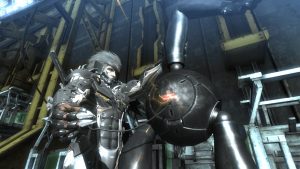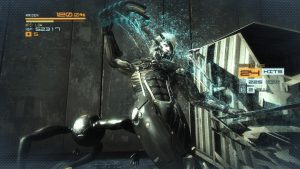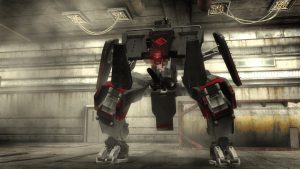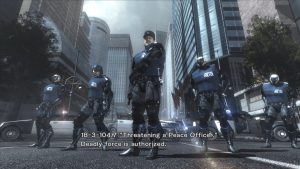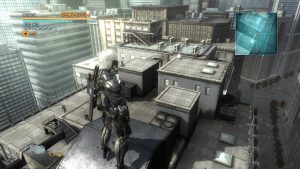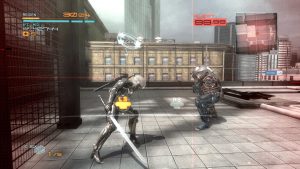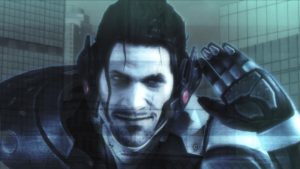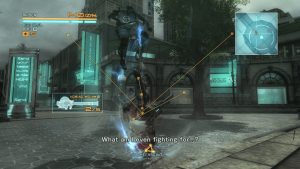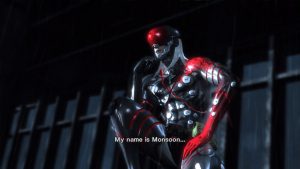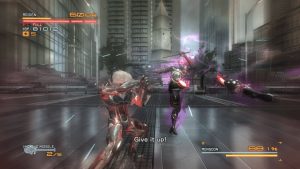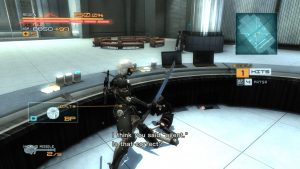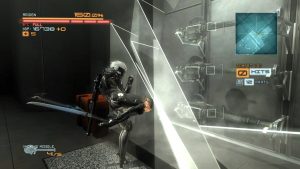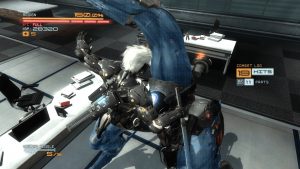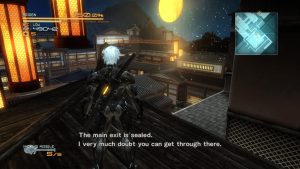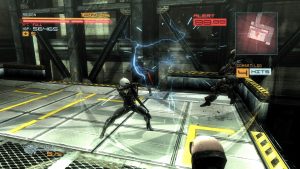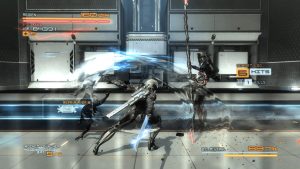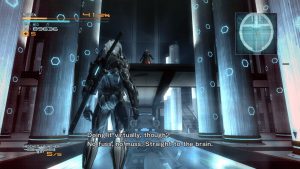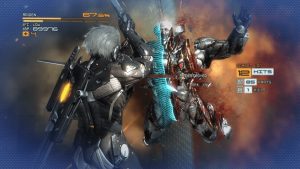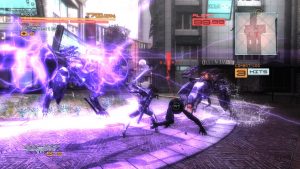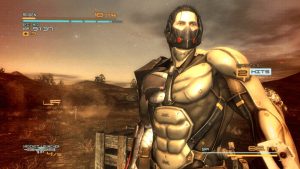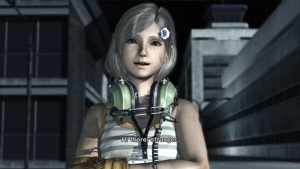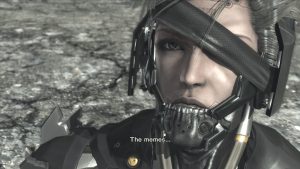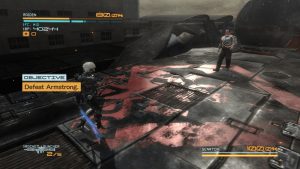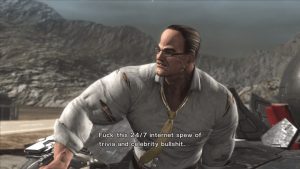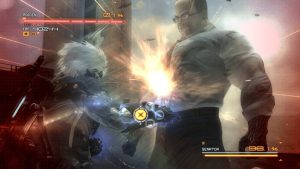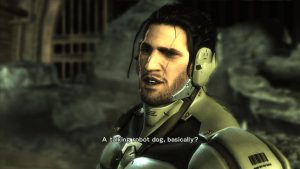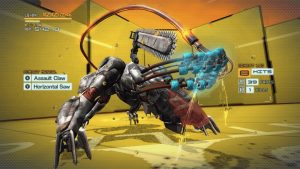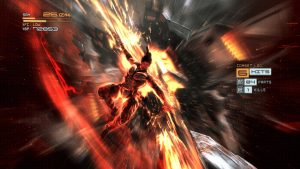- Metal Gear
- Snake’s Revenge
- Metal Gear 2: Solid Snake
- Metal Gear Solid
- Metal Gear Solid Integral Staff Commentary
- Metal Gear Solid (Game Boy Color)
- Metal Gear Solid 2: Sons of Liberty
- Document of Metal Gear Solid 2, The
- Metal Gear Solid: The Twin Snakes
- Metal Gear Solid 3: Snake Eater
- Metal Gear Solid 4: Guns of the Patriots
- Metal Gear Solid: Portable Ops
- Metal Gear Solid: Peace Walker
- Metal Gear Solid V: Ground Zeroes
- Metal Gear Solid V: The Phantom Pain
- Metal Gear Rising: Revengeance
- Metal Gear Touch
- Metal Gear Acid
- Metal Gear Acid 2
- Metal Gear Solid Mobile
“The memes…”
After Metal Gear Solid 4’s release, work began on many different titles in the series. One of the most highly anticipated of this new wave of games was a spin off title staring Raiden set before the events of MGS4, detailing what he was up to after the Big Shell Incident. The emphasis was set on action and swordplay, over stealth and sneaking, carving out a place in the series as a unique title. Well, at least once it finally got released. Metal Gear as a series isn’t really known for being subtle, but Metal Gear Rising Revengence is a loud and flashy cut above the rest of the series, in that regard.
It did, however, take some work to get the game off the ground. The game was first unveiled, under the title Metal Gear Solid: Rising, in 2009, oddly enough at Microsoft’s E3 conference. Kojima Productions focused on swordplay action for this spin off, wanting to create a game that reflected Raiden’s wildly choreographed cutscenes in MGS4. The original reveal trailer ended with the character slicing a watermelon into sections, getting it ready for a summer picnic. While it looked impressive, the developers ran into problems making this cutting system feel good during the game. It languished in development hell for a couple of years – effectively canceled – before being handed off to Platinum Games around 2011. Like Metal Gear Solid 2, a demo was packaged with the Zone of the Enders HD Collection in January 2013, with the game releasing for the Xbox 360 and PS3 in February the same year. A PC version popped up on Steam in early 2014, along with a port to NVidia’s Shield platform. A macOS port exists, curiously, but thanks to the company that made it, Transgaming Inc., taking DRM servers offline after the company closed, it no longer runs.
With the overhaul at Platinum Games, a new story was written by Etsu Tamari. The writer had previously contributed to Peace Walker and would later go on to help with MGSV. The war economy created by the Patriots has suffered severe setbacks after the severing of their network in Metal Gear Solid 4, but there are those who don’t want to leave it behind. Raiden, working for Maverick Security Consulting, escorts the president of an undefined African nation when they are attacked by cyborgs from a rival PMC group called Desperado. After nearly losing his life in the attack, the cyborg recovers and sets out to track down those responsible, unraveling a vast & twisted conspiracy spanning the globe.
Tamari said that he looked to MGS2 when he rewrote the story, which makes sense given its star. Raiden’s history as a child soldier and his quest for self-understanding both drive the story. The games share themes, such as examining the place of violence in a free society and the spread of misinformation as a means for control. MGR also shares the same knack as Sons of Liberty in prognosticating the future. At the center of the story is a corrupt US senator who broadcasts a nauseatingly familiar sentiment like those bandied about during the country’s disastrous 2016 presidential election and has become the source of much memery. The story feels rushed by the end, however, with chapters and story beats going by fast. It also doesn’t help that two DLC campaigns – one focused on Jetstream Sam, Raiden’s foil in the story who nearly ends him in the prologue & another for Blade Wolf, the adversarial sentient cyborg dog who eventually helps Raiden in the main story – are short, as welcomed as it is to cover some needed ground with characters the game glosses over.
While its story & look reflects Kojima Productions’ sensibilities, MGR fits neatly into Platinum Games’ style of character action games. Raiden dances around with his blade, attacking and dodging enemies with all the dazzle of Bayonetta and the bravado of Dante, but it’s not all hack and slash to win. He is fast, able to employ his ninja skills to climb walls and block bullets. The blade mechanics that were apart of the original vision were integrated into the combat. Raiden can activate Blade mode and slice through enemies’ limbs or break off their armor. At the right moment, he can perform a Zandatsu strike, when an enemy is weakened or staggered, allowing him to grab their cybernetic cores to replenish his health and earn extra points. Later in the game, he unlocks Ripper Mode, only activated at full bars. In this mode, Raiden unleashes his full potential, cutting through enemies freely and without abandon for a short time.
Metal Gear Rising doesn’t forget its origins, despite being an action-oriented spin off. VR Missions return, serving as tutorial and as extra challenges. Unlike in the main series, they are unlocked by finding them during the game, with a pack of harder ones available as paid DLC. Raiden can unlock costumes, with others being pre-order bonuses, that make him look like he did in MGS4 or don on Gray Fox’s cybernetic get-up as well. Pinging the codec can be used to save, just like in the main series, despite autosaving at checkpoints. There’s a Soliton radar on screen mapping enemy movements, and AR Vision point out where items and enemies are lurking. There are stealth sequences where Raiden can avoid fights if he’s as nimble as a ninja, and he can find barrels and cardboard boxes to sneak around in. In practice, it isn’t as reliable as in the main series. The enemies’ lines of sight are unclear and their patterns are random.
Of course, this being a PlatinumGames joint, combat is the main appeal, but MGR shares some of the problem their other games exhibit, like difficulty spikes and camera issues. Parrying is the name of the game, with Raiden able to deflect attacks all around him. Enemies telegraph their attacks, with a red flash meaning it can be parried & yellow meaning it’s impervious. Mastering it is key, and some punishing boss fights early on are meant to emphasize this. Raiden is more vulnerable than his character action peers. He’s easily made dizzy, and it takes a Mario Party level of analog stick waggling to get him out of that state. The camera is a handful to manage, especially in tight corridors and rooms. As with some other Platinum games, it will often lock on to an enemy far away. All of this makes for a frustrating game to play on the first time through. It’s a game that really opens up on successive playthroughs, with some upgrades bought and the muscle memory built up in your thumbs.
The game looks and performs well. The action is fast and flashy, and the performance is consistent. It takes a lot of visual cues from MGS4, like the sepia-toned look and muted color palette. An impressive amount of the environment can be cut up. This isn’t Red Faction; Raiden can’t literally cut a path through the level, but trees, boxes, cars, and more all react to his sword slash, as they did in the original reveal trailer. Soldiers tumble off a balcony after its supports are knocked out, slicing through missiles is totally a valid strategy, and a tower of boxes convincingly tumble to the ground when the base is attacked. Being as this takes place after the fall of the Patriots, many enemy designs are variations on earlier ones. The little 3 armed Dwarf Geckos return, as goofy looking as ever, along with their more imposing, bipedal counter parts. Cyborg cops attack with giant swords & hammers, and a hulking ape-like creatures with huge cylindrical arms tosses Raiden around when they get a hold of him. Bosses come in some unique designs as well. One boss, Monsoon, has an entirely magnetic body, with individual parts leaping out of the way of Raiden’s blade when he attacks. Another, Mistral, piles on the Dwarf Geckos for armor, plugging their arms together to create her weapon.
The music in Metal Gear Rising is perhaps the most memorable part. Since this isn’t a sneaking mission, the game trades its usual tense, symphonic sound for a fast and loud nu metal one. Jamie Christopherson serves as the main composer, and the soundtrack includes lyrical & musical contributions from metal and rock artists. Just a sample of the titles – “It Has To Be This Way”, “The War Still Rages Within”, and “The Only Thing I Know For Real” – broadcast what the OST is going for, vibing well with Raiden’s character development and the kinetic action of Platinum’s game design. It’s truly elevates the crazy boss fights, as everything’s exploding & characters fly through the air like gravity ain’t a thing, and then the lyrics kick in at just the right moment, like a climactic battle in a shonen anime. It’s just so campy & extra that it comes back around to being endearing.
Metal Gear Rising: Revengence is over-the-top and edgy in all the right ways. It’s self-aware enough to not go too far, unlike MGS4. It knows precisely just how ridiculous it’s being, with its brash attitude, cyborg samurais sporting rocket powered sword sheathes, and roaring Hot Topic soundtrack. Outside of appearing in Ground Zeroes‘ bonus Jamias Vu mission, Raiden didn’t get another shot at the protagonist mantle. And that’s a shame. This is a game where you can *parry* Metal Gear RAY’s foot as it stomp on you. It’s Kojima Productions at their best, with the finest gameplay that Platinum has to offer, making it a dream collab between titans of the Japanese game development scene, akin to Chrono Trigger. With Konami & Kojima Productions (& Platinum, for that matter) being much different companies now, it seems like a collaboration that’s unlikely to happen again. At the very least, Revengence exists and is a blast to play.
